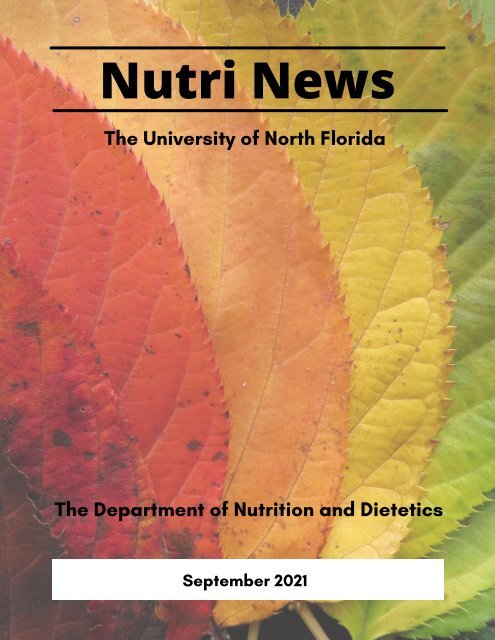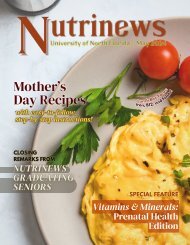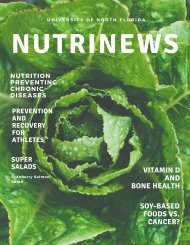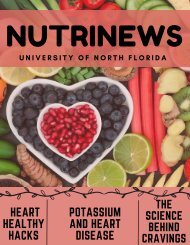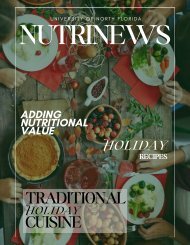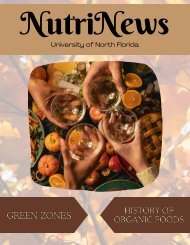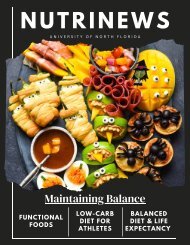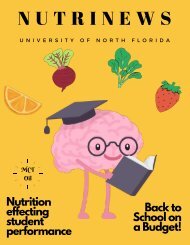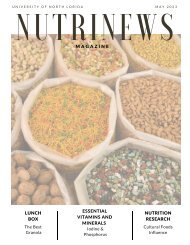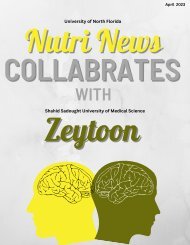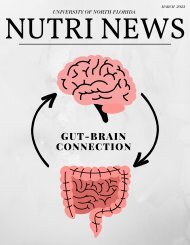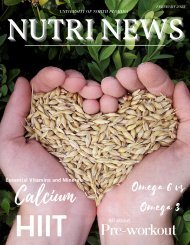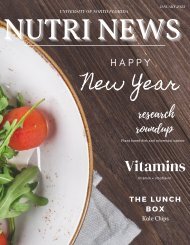You also want an ePaper? Increase the reach of your titles
YUMPU automatically turns print PDFs into web optimized ePapers that Google loves.
Nutri News<br />
The University of North Florida<br />
The Department of Nutrition and Dietetics<br />
<strong>September</strong> <strong>2021</strong>
TABLE OF<br />
CONTENTS<br />
C O V I D C O R N E R<br />
U N F N U T R I T I O N C L U B U P D A T E S<br />
N U T R I T I O N R E S E A R C H<br />
N U T R I T I O N S C I E N C E R E S E A R C H<br />
S T U D E N T S P O T L I G H T<br />
T H E L U N C H B O X<br />
M Y T H - B U S T I N G<br />
D A Y I N T H E L I F E O F A C O L L E G E S T U D E N T<br />
S H O P P I N G I N S E A S O N<br />
M O N T H L Y H A C K S<br />
F A C U L T Y S P O T L I G H T<br />
M E E T T H E S T A F F<br />
2<br />
5<br />
8<br />
11<br />
15<br />
17<br />
20<br />
24<br />
29<br />
31<br />
34<br />
38<br />
1
UNF COVID<br />
CORNER<br />
Positive cases are once again on the rise, and the<br />
health and safety of all UNF students, faculty, and<br />
staff are a top priority as always. Therefore, the<br />
University’s COVID-19 Task Force has released<br />
new campus updates:<br />
Masks: Even though it is not mandated, masks<br />
are expected to be worn in all campus spaces<br />
both indoor and outdoor. This is to prevent the<br />
spread of the newest COVID strain which can be<br />
transmitted to those who are vaccinated and<br />
unvaccinated.<br />
Vaccine Incentive Program: From the second<br />
week of <strong>September</strong> through the end of October,<br />
all currently enrolled UNF students who present<br />
a copy of their CDC vaccination card will be<br />
eligible to receive $100 Ozzie Bucks. The<br />
student Health website has instructions for both<br />
electronic and in-person card submission.<br />
Ozzie Bucks can be used at most on-campus<br />
dining and vending machines, the bookstore,<br />
student wellness center, parking services,<br />
student health services, laundry facilities, the<br />
library for printing, and more.<br />
B Y L A U R A R O G E R S<br />
2
WITH A RETURN TO CAMPUS, WE KNOW THAT IT HAS<br />
BEEN HIGHLY RECOMMENDED FOR ALL TO GET THE<br />
COVID-19 VACCINE. HOWEVER, THERE ARE MANY WHO<br />
ARE HESITANT TO GET THE VACCINE. HERE IS A<br />
SHORTLIST OF CONCERNS ASSOCIATED WITH THE<br />
VACCINE, WHICH THE CDC HAS ANSWERED:<br />
· REPRODUCTION – WILL THE VACCINE PREVENT<br />
CONCEIVING FUTURE CHILDREN?<br />
NO. THERE IS NOT ANY EVIDENCE OF THE VACCINE CAUSING<br />
INFERTILITY OR FETUS DEVELOPMENTAL ISSUES.1<br />
· WILL THE VACCINE ALTER MY DNA?<br />
NO. THE VACCINE IS MEANT TO TEACH OUR CELLS HOW TO<br />
FIGHT THE VIRUS AND DOES NOT CHANGE OUR DNA. THE<br />
COMPONENTS THAT MAKE UP THE VACCINE DO NOT ENTER<br />
THE NUCLEUS OF OUR CELLS, WHICH IS WHERE DNA IS<br />
HOUSED. 1<br />
· CAN I CONTRACT THE COVID-19 VIRUS FROM THE VACCINE?<br />
NO. THE VACCINE DOES NOT CONTAIN A LIVE VIRUS.1<br />
· WILL THE INJECTION SITE BECOME MAGNETIC?<br />
NO. THE VACCINE DOES NOT CONTAIN ANY METALS.1<br />
· DOES THE EMERGENCY USE AUTHORIZATION (EUA) OF THE<br />
VACCINE MEAN THAT IT IS LESS SAFE?<br />
NO. THE FDA DETERMINES IF A VACCINE EUA IS NECESSARY.<br />
IN THIS SITUATION, VACCINES ARE STILL THOROUGHLY<br />
TESTED AND REQUIRE THE SUBMISSION OF CHEMISTRY,<br />
MANUFACTURING, AND CONTROLS IN-FORMATION, AS WELL<br />
AS SAFETY DATA ACROSS 3 PHASES OF CLINICAL TRIALS.<br />
THE FDA ASSURES THAT THE SPEED AT WHICH THE VACCINE<br />
WAS DEVELOPED HAS NOT SACRIFICED “SCIENTIFIC<br />
STANDARDS, INTEGRITY OF THE VACCINE REVIEW PROCESS,<br />
OR SAFETY.”2<br />
3
S A F E T Y F I R T S ! !<br />
S o c i a l c r e a t u r e s a s w e a r e , m y t h s<br />
a n d m i s c o n c e p t i o n s q u i c k l y a r i s e<br />
a s w e p a s s i n f o r m a t i o n t o e a c h<br />
o t h e r . H o p e f u l l y , s h e d d i n g l i g h t<br />
o n s o m e o f t h e s e c o n c e r n s h a s<br />
e a s e d t h e m i n d s o f s o m e . E i t h e r<br />
w a y , e v e n t h o u g h t h e U n i v e r s i t y<br />
c a n n o t m a k e t h e v a c c i n a t i o n<br />
m a n d a t o r y , i t i s s t r o n g l y<br />
s u g g e s t e d t o k e e p a l l o n c a m p u s<br />
s a f e r . W e a r e a b l e t o e n j o y<br />
e x p e r i e n c i n g c a m p u s t h i s<br />
s e m e s t e r b e c a u s e o f t h e h a r d<br />
w o r k p u t f o r t h b y e v e r y o n e<br />
c o m i n g t o g e t h e r t o f o l l o w C O V I D<br />
s a f e t y g u i d e l i n e s . L e t ’ s c o n t i n u e<br />
t h e s a m e p o s i t i v e p r o j e c t i o n b y<br />
c o n t i n u i n g t o p r a c t i c e p r o p e r<br />
h y g i e n e , s o c i a l d i s t a n c i n g ,<br />
g e t t i n g v a c c i n a t e d , a n d w e a r i n g<br />
f a c e m a s k s . W e a r e a l l i n t h i s<br />
t o g e t h e r . S t a y s a f e , O s p r e y s<br />
R E F E R E N C E S<br />
1 . M Y T H S & F A C T S . C E N T E R F O R D I S E A S E C O N T R O L A N D<br />
P R E V E N T I O N . H T T P S : / / W W W . C D C . G O V / C O R O N A V I R U S / 2 0 1 9 -<br />
N C O V / V A C C I N E S / F A C T S . H T M L U P D A T E D J U L Y 7 , 2 0 2 1 . A C -<br />
C E S S E D A U G U S T 4 , 2 0 2 1 .<br />
2 . E M E R G E N C Y U S E A U T H O R I Z A T I O N F O R V A C C I N E S<br />
E X P L A I N E D . U . S . F O O D A N D D R U G A D M I N I S T R A T I O N .<br />
H T T P S : / / W W W . F D A . G O V / V A C C I N E S - B L O O D -<br />
B I O L O G I C S / V A C C I N E S / E M E R G E N C Y - U S E - A U T H O R I Z A T I O N -<br />
V A C C I N E S - E X P L A I N E D U P D A T E D N O V E M B E R 2 0 , 2 0 2 0 .<br />
A C C E S S E D A U G U S T 1 0 , 2 0 2 1<br />
4
Nutrition Clubs<br />
By: Laura Rodgers<br />
As Dietetics majors, getting involved in the field not only looks nice on paper, it is also<br />
a great way to build relationships with others who share the same passions. As the<br />
field of dietetics is relatively small, building relationships and becoming better<br />
acquainted with those in the field may prove to be valuable connections as you<br />
progress within your career. Most importantly for the present, joining and participating<br />
in a nutrition club is simply enjoyable.<br />
Nutrition Clubs Joint Meeting <strong>September</strong> 1st at 10 am via Zoom<br />
All of the nutrition clubs will be represented by their officers, introduce the club's<br />
values, and present their goals for the year.<br />
Market Days Wednesdays at the Student Union, Osprey Plaza<br />
Not only do many outside businesses and vendors appear at the market days, but a lot<br />
of student organizations have tables out as well. <strong>September</strong> 1st, 8th, 22nd, and 29th<br />
are the dates to mark on your calendar. Take a walk around the plaza to become<br />
better acquainted with the many clubs, including nutrition clubs. You may even score<br />
some swag or participate in a fun activity!<br />
5
Monthly Meeting Schedules:<br />
SNDA – Student Nutrition and Dietetic Association<br />
Meeting every 2nd Wednesday at 10 am<br />
@unf_snda<br />
NDLA – Nutrition and Dietetic Leadership Association<br />
Meeting every 2nd Monday at 3 pm<br />
@unf_ndla<br />
NJC – Nutrition Journal Club<br />
Meeting every 1st Wednesday at 10 am<br />
@unf_njc<br />
UNF Cooking Club<br />
Meeting every 3rd Thursday at 6 pm<br />
@unfcookingclub<br />
Slow Food UNF<br />
Meeting every last Friday<br />
@slowfoodunf<br />
6
7
Diets Don’t Work!<br />
Here’s Why:<br />
The U.S. weight loss and diet industry reached<br />
a record worth of $78 billion in 2019 and the<br />
global weight-loss industry is expected to be<br />
worth $278.95 billion by 2023.1 Is the diet<br />
industry so profitable because diets work? Or<br />
because they don’t?<br />
Research shows that up to 95% of all diets fail<br />
—meaning that the individual may have gained<br />
all the weight lost back, and then some. In a<br />
meta-analysis of 29 long-term weight-loss<br />
studies, more than half of the weight lost was<br />
regained within two years, and by five years<br />
more than 80% of the lost weight was<br />
regained.2 It’s not losing the initial weight that’s<br />
unsuccessful, but keeping the weight off. In<br />
part, we have our bodies to thank for that.<br />
When we lose weight and body fat, our<br />
metabolisms can also drop and work less<br />
efficiently. Even if you regain the weight back,<br />
your metabolism may not catch back up. This<br />
means that the body at rest will burn fewer<br />
calories than it used to.3 This is best<br />
highlighted by the Biggest Loser study.<br />
Participants that were on the show The Biggest<br />
Loser became much more efficient at utilizing<br />
calories by lowering the body’s need for energy<br />
(decreasing metabolism), and this effect<br />
persisted for six years after dieting!3<br />
Additionally, as an individual loses weight their<br />
body adapts through mechanisms that increase<br />
appetite and decrease satiety (fullness). One<br />
study even found that the body will prompt us<br />
to eat an extra 100 calories for every 2 pounds<br />
of weight that we lose!4 This means that the<br />
more weight you lose, the hungrier you<br />
become. Our bodies are almost conspiring<br />
against long-term weight maintenance!<br />
Not only are our bodies biologically wired to<br />
fight back against weight loss and diet<br />
restriction, but so are our minds. A diet is a<br />
period of food restriction that puts your body<br />
into a state of deprivation. Deprivation is not<br />
just from calories but from foods you love and<br />
even activities you may enjoy. Anyone with a<br />
child knows, when you tell them “no, you can’t<br />
have that”, they want it even more! The same<br />
thing goes for a dieting body. This is why it’s so<br />
hard for an individual to stick to a period of<br />
strict restriction.<br />
8
The restriction period (weight loss) often<br />
leads to a binging period (weight gain) and<br />
the cycle is repeated constantly throughout<br />
the life of a dieter! Psychologists call this<br />
the “Dieter’s Dilemma”. The Dieter’s<br />
Dilemma starts with a desire to be thin,<br />
which leads to dieting, which leads to<br />
cravings and reduced self-control, which<br />
leads to loss of control and overeating,<br />
which leads to regaining of lost weight, and<br />
again back to the desire to be thin and<br />
starting the whole malicious cycle over!1<br />
Simple ways to step out of diet culture and<br />
into true health and wellness can include:<br />
engaging in movement you enjoy, focusing<br />
on adding beneficial foods to the diet<br />
instead of taking foods away, and shifting<br />
away from using the scale as your main<br />
measure of progress.<br />
Instead of focusing on weight loss, many<br />
health professionals and researchers are<br />
calling for a paradigm shift towards a<br />
behavior change focus.5 Weight is not a<br />
behavior, and thus should not be the focus<br />
of behavior change strategies. Instead of<br />
focusing on how quickly the body can lose<br />
weight, focus on how to make the body feel<br />
its best.<br />
By: Haley Brock<br />
. Tribole E, Resch E. Intuitive Eating: A Revolutionary Anti-Diet Approach. 4th ed. New York, New York: St. Martin's Essentials; 2020.<br />
. Anderson JW, Konz EC, Frederich RC, Wood CL. Long-term weight-loss maintenance: a meta-analysis of US studies. Am J Clin Nutr. 2001;74(5):579–584. Doi: https://doi.org/10.1093/ajcn/74.5.579<br />
. Fothergill E, Guo J, Howard L, et al. Persistent metabolic adaptation 6 years after "The Biggest Loser" competition. Obesity (Silver Spring). 2016;24(8):1612-1619. Doi: https://doi.org/10.1002/oby.21538<br />
. Polidori D, Sanghvi A, Seeley RJ, Hall KD. How strongly does appetite counter weight loss? Quantification of the feedback control of human energy intake. Obesity (Silver Spring). 2016;24(11):2289-2295. Doi:<br />
https://doi.org/10.1002/oby.21653<br />
. O’Hara L, Taylor J. What’s wrong with the ‘War on Obesity?’ A narrative review of the weight-centered health paradigm and development of the 3C framework to build critical competency for a paradigm shift. SAGE Open. April<br />
2018. Doi: https://doi.org/10.1177%2F2158244018772888<br />
9
R E C O M M E N D E D<br />
N O N - D I E T<br />
B O O K S<br />
For more science-based<br />
information about nondiet<br />
approaches, follow<br />
this link:<br />
https://haeshealthsheets.com<br />
10
Lobbying for<br />
MyPlate<br />
BY: SAMANTHA DILL<br />
Although it may be obvious, a food retailer’s<br />
success rate is based on how profitable their<br />
product is; an increase in profit margin or rate<br />
of inventory turnover increases the rate of<br />
return. In the food industry, the principle of<br />
mass merchandising encourages a high<br />
volume of sales with low net profit margins.1<br />
Four main types of companies run this market:<br />
producers, processors, distributors, and<br />
retailers. Lobbyists are the primary motivators<br />
of corporate political activity (CPA) behind the<br />
scenes; they usually act through means of<br />
persuasion such as monetary contributions.2<br />
The overall goal of a lobbyist is to influence<br />
politicians to pass the legislature in support of<br />
their company.<br />
In 2018, the company Nestlé provided<br />
products such as infant formula for the USDA’s<br />
Special Supplemental Nutrition Program for<br />
Women, Infants, & Children (WIC) recipients in<br />
almost every state. The main ingredient of<br />
infant formula, bovine (cow) milk, is<br />
inexpensive due to government subsidies.<br />
WIC provides vouchers to its participants to<br />
purchase foods such as fortified infant formula<br />
and is responsible for over half of the infant<br />
formula sold in the US.2 Nestlé offers a<br />
discounted price for the breastmilk substitute,<br />
so much so that WIC only pays 8% of the<br />
wholesale price tag.2 Despite the discount,<br />
Nestlé’s market share increased by 74%.<br />
The USDA developed the MyPlate initiative in<br />
2010, using the results of the White House<br />
Childhood Obesity Taskforce, as a simpler<br />
form of the food pyramid.3 This graphic shows<br />
that fruits and vegetables should make up at<br />
least half of a person’s food intake. Regardless<br />
of this recommendation, only 3% of the United<br />
States’ cropland is occupied by fruits and<br />
vegetables, and limited funding is allocated<br />
towards supporting specialty crop programs.1<br />
11
Fruit and vegetable farmers are ineligible for<br />
direct support via government subsidies if<br />
they plant commodity crops, such as corn,<br />
on land that receives those subsidies. Crop<br />
insurance is a form of “safety net program”<br />
offered by the government for specialty<br />
crops to limit the financial toll of agriculture<br />
and offers the lobbying companies a greater<br />
opportunity for marketing to farmers.<br />
Congress has greatly expanded farmer<br />
subsidies to encourage the purchase of this<br />
insurance; the USDA pays around “62% of<br />
farmers’ premium subsidies and $1.3 billion<br />
to insurance companies and agents that sell<br />
the policies”.1.<br />
The Union of Concerned Scientists (UCS)<br />
advocates for the expanded production of<br />
healthy foods. They vouch for the<br />
elimination of certain subsidized agricultural<br />
operations, as they discourage farmers from<br />
planting MyPlate-friendly fruits and<br />
vegetables versus commodity crops. Since<br />
corn, milk, meat, and eggs receive the most<br />
government subsidies (and therefore<br />
lobbyist attention), this can skew the USDA’s<br />
MyPlate initiative.<br />
Consumers and activists can join the efforts<br />
of groups like the UCS to pressure legislators<br />
into the implementation of policy change.<br />
Changes will have to start at the local level.<br />
12<br />
1. Chapter 2 U.S. Agricultural Policies and the U.S. Food Industry: Production to Retail. In: Local Food Environments. CRC Press; 2015:54-87. doi:10.1201/b17351-8<br />
2. Tanrikulu H, Neri D, Robertson A, Mialon M. Corporate political activity of the baby food industry: the example of Nestle in the United States of America. International Breastfeeding Journal. 2020;15(1):22-22.<br />
doi:10.1186/s13006-020-00268-x<br />
3. USDA's MyPlate Celebrates Its First Anniversary. U.S. Department of Agriculture. Published May 30, 2012. Accessed July 21, <strong>2021</strong>. https://www.usda.gov/media/press-releases/2012/05/30/usdas-myplate-celebrates-its-firstanniversary
13
F O O D<br />
S T O P<br />
D I E T I N G<br />
Freedom<br />
According to the Journal of Obesity, constant weight<br />
loss and weight gain can cause higher mortality,<br />
chronic diseases, inflammation, specific types of<br />
cancer, non-Hodgkin's lymphoma, gallstone attacks,<br />
and osteoprotoic fractures.<br />
T H R O W A W A Y<br />
T H E S C A L E<br />
The number on the scale<br />
does not determine your<br />
health.<br />
D E L E T E F O O D<br />
T R A C K I N G A P P S<br />
Don't let food control you!<br />
Be free and eat intuitively<br />
14
By: Carol Riggins<br />
Student Spotlight: Iyanu Saka<br />
Welcome to <strong>September</strong>! This month, our Student in the Spotlight is Iyanu Saka. Iyanu was born in<br />
Lagos, Nigeria and moved across the globe to Jacksonville with her family when she was seventeen<br />
months old. She and her family have been here since! Iyanu is a sophomore this year, and she<br />
donates much of her time as a volunteer for Meals on Wings, Feeding Northeast Florida, and the Jax<br />
Humane Society. She is also the secretary for the Student Nutrition and Dietetics Association and a<br />
facilitator for the Honors Program. Iyanu has always been a driven student. In high school, she sold<br />
brownies to raise money for sports and extracurricular activities. She earned more than $1,000<br />
dollars in three years to purchase her own uniforms and honor society dues. Talk about motivated!<br />
Read further to learn more about Iyanu and her school journey up to this point.<br />
CR: What inspired you to pursue a degree in Nutrition and Dietetics?<br />
IS: My dad was diagnosed with pre-diabetes. At this time, I got into healthy eating, or what I thought that meant at the<br />
time. Counting calories, avoiding carbs, and throwing out anything with added sugar. At the end of a few months, I<br />
realized that I had created a monster. My dad wasn’t eating anything because it was “too high in carbs” and he was<br />
miserable. He worked long hours doing laborious work, so it was especially taxing on his body without proper fuel. Since<br />
then, I’ve spent most of my time educating him about proper nutrition based on the principles I’ve learned in my nutrition<br />
courses and read from registered dietitians. I’ve also been applying this information to myself, and other members of my<br />
family. Nowadays, I’ve graduated to intuitive eating, gentle nutrition, and studying human behavior. Oh, and I’ve stopped<br />
giving nutritional advice outside of my immediate family. I recommend reaching out to a professional dietitian, like the<br />
ones on campus, and if they insist, I point to national guideline.<br />
CR: What has been your favorite class or experience thus far since becoming a dietetics student at<br />
UNF?<br />
IS: My favorite class has been Food Fundamentals taught by Professor Baron. I liked this class because it was easy<br />
to follow and interesting. I found out why dietitians and health experts pushed fruit, veggies, and whole grains so<br />
intensely. It’s because they’re so rich in nutrients and so amazing for us that we haven’t even found out all the<br />
ways in which they benefit us. This class also pushed me to try more foods such as lentils and soy milk.<br />
15
CR: What hobbies or activities do you most enjoy doing outside of the University?<br />
IS: I really enjoy watching TV. My brain gets to shut down and I love laughing while watching my favorite TV shows such<br />
as Cougar Town, The Mindy Project, and Friends. I also love hanging out with my friends. I don’t have a favorite<br />
restaurant or activity because I think if you’re with the right people, you could be watching paint dry and still have fun.<br />
Reading books is also a great way to get more information or enjoy a funny story. My favorite genres are self-help and<br />
young adult fiction<br />
CR: What goals or aspirations do you have for after graduation?<br />
IS: After graduation, my goal is to get a scholarship and attend an MSDI fully funded. After speaking with the interns, I<br />
think I might want to apply to UNF to continue my education. However, I’m not opposed to moving across the country or<br />
somewhere else in Florida. I’ve been told that I have a “business spirit” about me, so I might consider opening my own<br />
business.<br />
CR: Can you tell us about any volunteer work you have done, and what your favorite volunteer<br />
opportunity was?<br />
IS: I love volunteering at Meals on Wings on campus and the mobile food drives with Feeding Northeast FL. With Meals on<br />
Wings, we’re diverting food waste and repurposing them into balanced and nutritious meals for food-insecure seniors. The<br />
smile alone that you get from a senior when you hand them a bag of meals keeps you coming back. I also love hearing their<br />
stories and compliments of the meals. With the mobile food drives, I like seeing a group of total strangers come together to<br />
make sure everyone in line gets something to eat. I love the cooperation and teamwork, and it just makes waking up before<br />
noon that much more fun.<br />
CR: Do you have any advice for new Dietetics students entering the program?<br />
IS: Get involved ASAP. I started with Meals on Wings in the Spring of my freshman year, and I’ve already met many of the<br />
spearheads of the program, including Dr. Ross, Dr. Wright, and a slew of seniors. I get tips about classes, textbooks, and<br />
available opportunities. It’s like having a bunch of older sisters who are determined to not let you make the same mistakes. I’ve<br />
also met and talked to many of the UNF MSDI interns and got their take on the program. I plan on catching up with them<br />
after graduation and seeing what their careers look like in a few years.<br />
CR: Do you have a favorite quote or mantra that you live by that you would like to share with others?<br />
IS: My senior quote was, “You regret more of the things that you don’t do than the ones you do” and I still live by this quote. I<br />
don’t think anyone remembers any of the super embarrassing stories I’ve told, and I’ve got too many awkward encounters to<br />
cringe about every single one. The only things I really remember are the chances I didn’t take, the people I didn’t start a<br />
conversation with, and the opportunities I missed out on because I was too afraid to even try. So, I urge others, to do more<br />
things just because you can. Talk to your crush, write your professor a thank-you note, apply for that job you’re not 100%<br />
qualified for just because you can.<br />
16
Chocolate Cupcakes with<br />
Chocolate Ganache Frosting<br />
Yield: 12 cupcakes<br />
Prep Time: 20-30 minutes<br />
Cook time: 15-18 minutes<br />
Total Time: 35-48 minutes<br />
INGREDIENTS<br />
Chocolate cupcakes<br />
½ cup full-fat coconut milk<br />
1 tbs apple cider vinegar<br />
2 eggs (may substitute with flax eggs)<br />
2/3 cup coconut sugar (may<br />
Chocolate Ganache Frosting<br />
1 cup full-fat coconut milk<br />
1 ½ cups dark or semisweet chocolate chips<br />
substitute with brown or white<br />
sugar)<br />
¼ cup coconut oil (melted and cooled)<br />
½ tbs vanilla<br />
1 ½ cup almond flour<br />
2/3 cup tapioca flour<br />
almond and tapioca flour may be<br />
substituted with 2 cups of oat flour<br />
2/3 cup cacao powder (cocoa powder<br />
may also work)<br />
1 tsp baking powder<br />
½ tsp baking soda<br />
½ cup warm coffee (or water)<br />
18
R E C I P E S<br />
INSTRUCTIONS:<br />
Chocolate Ganache Frosting<br />
In a pot, heat full-fat coconut milk over medium<br />
heat until it begins to simmer. Turn off the burner<br />
and move the pot to a cool burner.<br />
Add in the chocolate chips and stir until the<br />
chocolate is completely melted and the mixture is<br />
smooth.<br />
Transfer the chocolate mixture to a cool bowl and<br />
place it in the fridge for at least 1 hour to thicken<br />
while you work on your cupcakes.<br />
Yield: One 12-inch Pizza<br />
Time: hr min<br />
Chocolate Cupcakes<br />
Total 30 2<br />
1. Preheat the oven to 350 degrees F.<br />
2.<br />
Brew coffee, set aside to cool.<br />
Wet mixture:<br />
Prepare dairy-free buttermilk by mixing the<br />
coconut milk and apple cider vinegar in a small bowl.<br />
Set aside.<br />
In a large mixing bowl, beat the eggs, coconut sugar,<br />
coconut oil, and vanilla together. The texture should<br />
be light and creamy. You may use an electric beater<br />
if you have one.<br />
Add the dairy-free buttermilk to the large mixing<br />
bowl and beat again to incorporate.<br />
Dry mixture<br />
a. In a medium bowl, thoroughly combine the<br />
almond flour, tapioca flour, cacao powder,<br />
baking powder, and baking soda.<br />
1. Fold the dry mixture into the wet mixture until<br />
there are no clumps. It is important to not over mix.<br />
2. Pour in warm coffee. Using a silicone spatula, fold<br />
the coffee into the mixture.<br />
3. Line a muffin pan with cupcake liners. Using an ice<br />
cream scoop, pour cupcake batter into the lined<br />
muffin pan. If any batter remains, go back and<br />
evenly distribute the remaining batter.<br />
4. Bake in the oven for 15-18 minutes. Allow cooling<br />
before icing.<br />
BY: PAIGE COURTIER<br />
Prep Time: 2 hr 15 min<br />
19
Busting<br />
Intuitive Eating vs. Meal Tracking: Which Method Works Better?<br />
Myth<br />
month’s myth busting article<br />
Last<br />
intermittent fasting and<br />
discussed<br />
results various dieting habits can<br />
the<br />
on health. The conclusion of<br />
have<br />
discussion revealed that there is<br />
the<br />
all-encompassing solution for<br />
no<br />
person, and that dieting needs<br />
every<br />
based on individual needs and<br />
vary<br />
When it comes to choosing<br />
goals.<br />
intuitive eating, also<br />
between<br />
to as mindful eating, or<br />
referred<br />
a carefully tracked diet, it<br />
following<br />
equally important to consider<br />
is<br />
needs and lifestyle factors<br />
individual<br />
food consumption as a form<br />
Tracking<br />
dieting can be beneficial for<br />
of<br />
with food allergies, people<br />
people<br />
chronic illnesses such as<br />
with<br />
and for those who have<br />
diabetes,<br />
goals for weight management<br />
specific<br />
hoping to gain muscle mass<br />
(athletes<br />
instance).<br />
for<br />
to make the healthiest choice.<br />
20<br />
By: Chloe Morgan
of the studies conducted on food<br />
Most<br />
have focused on whether the<br />
tracking<br />
results in significant weight loss<br />
method<br />
obesity is an epidemic and<br />
because<br />
to numerous chronic<br />
contributes<br />
While it has been shown that<br />
illnesses.<br />
trackers achieved more<br />
consistent<br />
weight loss attempts than<br />
successful<br />
trackers, one of the main<br />
inconsistent<br />
to tracking a diet is the ability<br />
benefits<br />
see instances of imbalance or<br />
to<br />
When a nutrition plan is<br />
malnutrition.1<br />
out, or a food diary accumulates<br />
written<br />
information, it becomes clear<br />
consistent<br />
a necessary food group is neglected<br />
if<br />
under-consumed and issues of this<br />
or<br />
are easily addressed.2 However,<br />
nature<br />
diet and nutrition are about<br />
because<br />
than weight loss and restrictions,<br />
more<br />
people might benefit more from<br />
some<br />
positive impacts on mental health<br />
the<br />
mindful consumption can provide.<br />
that<br />
or mindful eating is the<br />
Intuitive<br />
of relying on the body’s<br />
practice<br />
internal cues for hunger<br />
instinctual,<br />
than following societal or<br />
rather<br />
guidelines of appropriate<br />
external<br />
and meal plans.3<br />
mealtimes<br />
intuitive eating utilizes the<br />
Additionally,<br />
mindfulness principles practiced<br />
same<br />
meditation techniques. When eating<br />
in<br />
one should not only follow<br />
intuitively,<br />
sitting at a table and studying<br />
Imagine<br />
small chip on the place setting, the<br />
the<br />
rising off the plate, and the crunch<br />
steam<br />
that mouthwatering first bite. Being<br />
of<br />
while eating involves choosing a<br />
present<br />
carefully and engaging the senses<br />
meal<br />
savoring the smells, textures, and<br />
by<br />
of the food. Eating in this manner<br />
tastes<br />
leads to consuming smaller<br />
typically<br />
and eating at a slower pace.4<br />
portions<br />
to the reduced consumption of food,<br />
Due<br />
who engage in mindful eating<br />
those<br />
can often improve health<br />
practices<br />
better meal choices or lose<br />
through<br />
without following a restrictive<br />
weight<br />
Mindful eating practices have<br />
diet.4<br />
shown to correct compulsive<br />
been<br />
through reversal learning.5<br />
behaviors<br />
these thought processes can<br />
Retraining<br />
other areas of life as well,<br />
transform<br />
prsent during the eating experience.<br />
making mindfulness a powerful tool.<br />
natural hunger cues but should be fully<br />
21
summary, restricting diets that put<br />
In<br />
on weight loss without<br />
emphasis<br />
to nutritional needs and<br />
consideration<br />
health are never the best<br />
mental<br />
Tracking a diet can be a useful<br />
options.<br />
to ensure proper guidelines are<br />
method<br />
followed to control a chronic<br />
being<br />
or to avoid nutritional<br />
illness<br />
On the other hand, mindful<br />
deficiencies.<br />
allows the body to signal when it<br />
eating<br />
fuel and can also improve the<br />
needs<br />
connection. Following<br />
gut-to-mind<br />
hunger cues and then<br />
natural<br />
to journal what was<br />
proceeding<br />
could be another alternative<br />
consumed<br />
utilize the advantages of both<br />
to<br />
As long the body is receiving<br />
methods.<br />
and balanced fuel, and mental<br />
healthy<br />
does not decline, either method is<br />
health<br />
acceptable choice.<br />
an<br />
Ingels JS, Misra R, Stewart J, Lucke-Wold B, Shawley-<br />
1.<br />
S. The Effect of Adherence to Dietary Tracking on<br />
Brzoska<br />
Loss: Using HLM to Model Weight Loss over Time. J<br />
Weight<br />
Res. 2017;2017:6951495.<br />
Diabetes<br />
doi:10.1155/2017/6951495.<br />
McManus KD. Why keep a food diary? Harvard Medical<br />
2.<br />
Published January 31, 2019. Accessed July 26, <strong>2021</strong>.<br />
School.<br />
https://www.health.harvard.edu/blog/why-keep-a-fooddiary-2019013115855<br />
Warren JM, Smith N, Ashwell M. A structured literature<br />
3.<br />
on the role of mindfulness, mindful eating and<br />
review<br />
eating in changing eating behaviours:<br />
intuitive<br />
and associated potential mechanisms. Nutr<br />
effectiveness<br />
Rev. 2017;30(2):272-283. doi:<br />
Res<br />
10.1017/S0954422417000154.<br />
Nelson JB. Mindful Eating: The Art of Presence While You<br />
4.<br />
Diabetes Spectr. 2017;30(3):171-174. doi:10.2337/ds17-<br />
Eat.<br />
0015.<br />
Janssen LK, Duif I, van Loon I, et al. Greater mindful<br />
5.<br />
practice is associated with better reversal learning.<br />
eating<br />
References:<br />
Rep. 2018;8(1):5702. doi:10.1038/s41598-018-24001-1.<br />
Sci<br />
22
STEPS TO UTILIZE<br />
6<br />
A SUCCESSFUL<br />
FOR<br />
“Your personal growth is the only thing that matters. You own and<br />
write your story; no one else does. Believe in your unique steps up<br />
the mountain.”<br />
TOPIC:<br />
― Brittany Burgunder<br />
SEMESTER<br />
Make sure you have gathered all<br />
school supplies, lab coats, parking<br />
passes and read over each syllabus<br />
twice to make sure you have all<br />
items needed at your fingertips.<br />
Meal prep! Grab some easy to<br />
make recipes for the week, make<br />
sure your kitchen is stocked with<br />
great snacks for on the go and<br />
plan ahead meals so you know<br />
you are set up for success.<br />
STEP 1- STEP 2-<br />
STEP 3- STEP 4-<br />
Take time throughout the<br />
week to read, meditate, listen<br />
to a podcast or sit in a dark<br />
room and pray. This time is<br />
needed for mental clarity.<br />
Do not be afraid to get your<br />
sweat on! Enjoy a workout at<br />
your favorite gym, play a<br />
sports game with your family<br />
or take a jog around the block<br />
to get a workout in at least 3<br />
times per week.<br />
5- 6- STEP STEP<br />
Take one task at a time and<br />
Before bedtime, put your<br />
make sure you write down phone or computer away 45<br />
assignment due dates either in minutes prior to sleep. This<br />
your planner or phone calendar<br />
will allow the brain to<br />
for reminders. This is a great<br />
recoup and allow for as<br />
way to not feel overwhelmed. much deep sleep as possible.<br />
23
A DAY IN THE LIFE<br />
OF A COLLEGE<br />
STUDENT<br />
COLLEGE LIFE LOOKS DIFFERENT FOR EVERYONE, BUT HERE IN<br />
FLORIDA A TYPICAL DAY IS FILLED WITH STUDYING AND<br />
SUNSHINE:<br />
7:00 AM Rise and shine! I try waking up at a set time during the<br />
week to stay on track. I start my morning refresh routine and then<br />
have some breakfast. I typically make an oatmeal or yo-gurt bowl<br />
with fruit and eggs or a bagel. Here’s what my breakfast looked<br />
like today.<br />
24
8:00 AM IT’S COFFEE TIME, AND I GO OVER MY PLANNER TO-DO LIST<br />
AND PRIORITIZE TASKS FOR THE DAY.<br />
8:30 AM I START THE DAY WITH<br />
THE HARDEST ASSIGNMENT,<br />
PROJECT, OR SUBJECT TO<br />
STUDY TO GET IT OUT OF THE<br />
WAY. IN BETWEEN STUDYING<br />
AND COMPLETING<br />
ASSIGNMENTS, I LIKE TO GET UP<br />
EVERY 30 MINUTES TO<br />
COMPLETE A SMALL TASK<br />
AROUND THE HOUSE AND GET<br />
SOME MOVEMENT IN.<br />
1:00 PM LUNCHTIME! I TRY<br />
TO CREATE A BALANCED<br />
MEAL FOR LUNCH TO KEEP<br />
ME ENERGIZED AND<br />
FOCUSED. THIS TYPICALLY<br />
INCLUDES A PROTEIN<br />
SOURCE, A VEGETABLE,<br />
AND A CARBOHYDRATE<br />
SOURCE. I WANTED TO<br />
HAVE MY LUNCH OUTSIDE<br />
TODAY, SO I PICKED UP A<br />
SMOOTHIE AND A<br />
SANDWICH AND ATE<br />
OUTSIDE.<br />
25<br />
A P P R O V E D !
2:00 PM BACK TO SCHOOLWORK AND COMPLETING ASSIGNMENTS. I<br />
LIKE TO FOLLOW THE 30-ON, 10-OFF METHOD WHERE SCHOOLWORK<br />
AND STUDYING IS DONE FOR 30 MINUTES OR SO FOLLOWED BY A<br />
10-MINUTE BREAK. THIS KEEPS MY STUDYING AND ASSIGNMENT<br />
COMPLETION EFFICIENT WITHOUT GETTING BURNT OUT. I ALSO<br />
LIKE TO TAKE SOME TIME TO STUDY OUTSIDE IF I CAN, OR AT A<br />
COFFEE SHOP, DEPENDING ON HOW MUCH TIME I HAVE AND HOW<br />
THE WEATHER IS.<br />
4:00 PM MID AFTERNOON WALK FOR SOME SUNSHINE OR STRETCH.<br />
I LIKE TO TAKE SOME TIME OUT OF MY DAY TO STRETCH OR GO<br />
FOR A SMALL WALK SO I’M NOT SITTING DOWN FOR LONG PERIODS.<br />
KEEPING ACTIVE THROUGHOUT THE DAY IS CRUCIAL.<br />
4:30 PM BACK TO SCHOOLWORK! I LIKE TO FINISH OFF MY DAY<br />
STRONG AND GET ASSIGNMENTS AND STUDYING DONE. I HAVE A<br />
FLEXIBLE WORK SCHEDULE, SO I WORK FOR A FEW HOURS ONCE<br />
SCHOOLWORK IS DONE.<br />
6:00 PM END OF SCHOOL, INTO DINNER. AROUND THIS TIME, I LIKE<br />
TO HEAT UP DINNER OR COOK A FRESH MEAL DEPENDING ON IF I<br />
HAVE A MEAL PREPPED OR NOT. I LIKE TO COOK DINNERS FOR MY<br />
BOYFRIEND AND I, SO I PUT ON SOME MUSIC AND COOK A MEAL.<br />
TODAY I RECREATED A RECIPE FROM AUGUST’S NUTRINEWS ISSUE.<br />
26
6:45 PM TIME TO EAT AND THEN<br />
REST AND DIGEST.<br />
8:00 PM JOYFUL MOVEMENT. I LIKE<br />
TO DO NIGHTLY YOGA OR WEIGHT<br />
TRAINING DEPENDING ON HOW I’M<br />
FEELING FROM MY DAY. SOMETIMES<br />
I HAVE PROJECTS THAT ARE DUE OR<br />
TESTS TO STUDY FOR, SO THIS IS<br />
MY FLEX TIME TO GET MORE DONE<br />
OR GET SOME JOYFUL ACTIVITY IN.<br />
9:30 PM WIND DOWNTIME. WHILE I<br />
DON’T GET TO SLEEP UNTIL AROUND<br />
MIDNIGHT EACH NIGHT, I DO START<br />
WINDING DOWN AND DOING MY<br />
NIGHTTIME ROUTINE AROUND 9:30.<br />
SOMETIMES THIS INCLUDES<br />
PRACTICING MINDFULNESS TO CALM<br />
MY MIND OR DOING GENTLE YOGA<br />
AT THIS TIME IF I WASN’T ABLE TO<br />
BEFORE.<br />
27
28
MUSCADINE<br />
GRAPES:<br />
THE<br />
FORGOTTEN<br />
AMERICAN<br />
FRUIT<br />
By: Cameron Glover<br />
You may have never heard of<br />
muscadine grapes, yet they have played<br />
a role in American history since the<br />
founding of our country. Muscadine<br />
grape vines were first discovered in the<br />
Roanoke colony, and in that same area<br />
the oldest living muscadine vine still<br />
thrives today.1 Muscadine grapes<br />
flourish in the Eastern United States,<br />
with plants all the way from Delaware<br />
to Florida, and as far west as Texas.2<br />
Muscadine grapes are probably less<br />
familiar because they have very thick<br />
skin and seeds inside, making it a little<br />
more difficult to consume than seedless<br />
varieties, thus limiting their popularity.<br />
29
However, the effort gives way to greater reward,<br />
as muscadine grapes tend to have a more<br />
complex and balanced sweetness, with a skin<br />
that treads the line between sour and sweet. The<br />
fruit explodes in your mouth as you bite it,<br />
especially when it is fully ripe. For the best<br />
flavor, wait until the fruit is so tender to the<br />
touch that you almost think it is rotten; that just<br />
means the flavor is better. If you bite into a firm<br />
one, you are likely to have a very sour grape.<br />
Avoid the seeds at all costs by spitting them out;<br />
biting them releases an overwhelmingly bitter<br />
flavor. Muscadines can be found in most<br />
supermarkets for surprisingly cheap. Expect to<br />
pay about five dollars for one container, which<br />
has more than enough to try out the fruit. If you<br />
are like me, you will become obsessed. Act<br />
quickly though, as these grapes are only<br />
available for a short period of time right at the<br />
peak of summer from July to August<br />
I make it a priority to buy them every time I find<br />
them at the farmer’s market because I know they<br />
do not last long. These grapes come in two<br />
different types: purple ones (bullet grapes) and<br />
green/yellow ones (scuppernongs). Both are<br />
delicious, but I find the green varieties to be<br />
much sweeter when fully ripened. Muscadine<br />
grapes can also be used to create a wine that is<br />
very popular in this region. A popular local<br />
winery that specializes in muscadine wine is the<br />
San Sebastian Winery, which is worth checking<br />
out for those over twenty-one. Muscadine<br />
grapes are a part of Eastern American<br />
agricultural heritage that is often overlooked<br />
and underappreciated. Give this unusual fruit a<br />
try on a hot summer day, and you will be<br />
surprised at how refreshing and juicy these<br />
grapes can be.<br />
30<br />
1. History: The Muscadine Heritage. North Carolina Muscadine Grape Association. https://www.ncmuscadinegrape.org/history/. Accessed August 1st, <strong>2021</strong>.<br />
2. Andersen PC, Sarkhosh A, Huff D, Breman J. The Muscadine Grape (Vitis Rotundifolia Michx): HS763/HS100, Rev. 10/2020”. EDIS 2020 (6). doi:10.32473/edis-hs100-2020.
O C U S O N G R O W T H , D I T C H D I E T<br />
F<br />
U L T U R E :<br />
C<br />
O C U S O N W H A T Y O U C A N A D D I N T O Y O U R<br />
F<br />
I F E . L<br />
MONTHLY HACKS:<br />
B Y M E L I S S A B R E N N A N , M . S .<br />
Transitioning back to in-person classes after the<br />
COVID hiatus brings both exciting and nervous<br />
energy, as a lot has changed since last year. For<br />
some, the stay-at-home orders threw off<br />
schedules and routines and resulted in many<br />
changes ranging from stress and weight gain to<br />
economic fluctuations. While schools, and the<br />
state in general, is opening back up and life is<br />
getting back to normal,” it is important to<br />
practice both mental and physical wellness to<br />
have a successful year. As you recreate routines,<br />
remember to engage in behaviors that serve you<br />
and do not fall prey to the diet culture mentality.<br />
Diet culture is meant to feed off of insecurities<br />
and quick fixes in order to reel in more<br />
consumers. Think of diet culture as a business<br />
trying to make money off failures, whereas a<br />
lifestyle focused on eating and exercising out of<br />
joy and respect for your body actually serves<br />
you. Here are a few tips for navigating the<br />
health space as we return back to in-person<br />
classes:<br />
Diet culture stems from restrictive practices<br />
designed to cut out parts of your lifestyle in<br />
hopes you will see short-term results. When<br />
thinking about long-term health and wellness,<br />
it is important to focus on what you can add to<br />
your life instead of what you have to stay away<br />
from. For some, that might look like adding in<br />
more fruits and vegetables into meals and<br />
snacks in order to increase fiber and nutrient<br />
consumption. For others, that might look like<br />
adding in joyful movement like dancing or<br />
walks on the beach to increase activity. It’s<br />
important to focus on how the activity is<br />
making you feel mentally and physically,<br />
instead of focusing on calories burned or<br />
compensating for meals. Thinking about health<br />
and wellness as behaviors you can adopt into<br />
your life to make it more balanced and<br />
fulfilled, will end up reaping more benefits<br />
than focusing on things to restrict and avoid.<br />
31
33
34<br />
FACULTY SPOTLIGHT<br />
A N I N T E R V I E W W I T H D R . B U T L E R<br />
1. Tell us about your background in<br />
nutrition from education to<br />
experience and how you came to be<br />
at UNF.<br />
I am originally from Okeechobee, Florida. It’s a<br />
very small town and I realized at a young age<br />
that if I wanted to leave that town, I had to do<br />
well in school. So that’s exactly what I did.<br />
I completed my undergraduate studies at FIU<br />
in nutrition and I wasn't sure what I wanted to<br />
do, but my grandmother sent me an article<br />
with different job descriptions, the one that<br />
piqued my interest was dietitian.<br />
So, I decided that was my path and completed<br />
a dietetic internship at Bay Pines VA Medical<br />
Center where Dr. Wright was the internship<br />
director. By the time I entered the internship<br />
Dr. Wright was no longer there, but I<br />
interviewed with her, and she was just as<br />
amazing then as she is now.<br />
After I completed my internship, I decided I<br />
wanted to do research and accepted a position<br />
as a research assistant in North Carolina.<br />
Later, I received my doctoral degree from<br />
UNC Chapel Hill and did a postdoc with<br />
the health disparities research and<br />
intervention program at the University of<br />
Florida. At this point, I was ready to<br />
transition away from research and<br />
wanted to live closer to my family, so I<br />
decided to move to Jacksonville. I reached<br />
out to Dr Wright to see if there were any<br />
open teaching positions at UNF and there<br />
was!<br />
I started teaching Community Nutrition<br />
as well as the Basic Principles of Nutrition<br />
in 2018. I still teach the Community<br />
course and have taken on Lifespan<br />
Nutrition.<br />
It’s always been a vision of mine to have a<br />
private practice and teach. I have always<br />
enjoyed public speaking and wanted to<br />
pass knowledge on to people. Sharing<br />
what I’ve learned with others is a passion<br />
of mine.
2. What’s your favorite part about being a<br />
professor?<br />
Interacting with students. I love being able to<br />
mentor and offer students support and guidance<br />
and help them understand that life is going to<br />
happen. I like to be a buffer between the<br />
pressure that academia can put on folks. I hope<br />
to be somebody who provides a source of<br />
grounded support.<br />
I love the student interaction in the classroom,<br />
having discussions, and hearing what students<br />
are thinking. And I love the one-on-one<br />
interactions with students, helping them come<br />
up with their own solutions to things they're<br />
dealing with. Whether that be an assignment or a<br />
personal interaction, I love helping people use<br />
their own inner resources to effect change in<br />
their lives because I think that's the most<br />
empowering way.<br />
The other thing I love about teaching is being<br />
able to introduce potential new topics that folks<br />
have never heard of before and promote social<br />
justice and racial and ethnic inclusion in the field<br />
of dietetics. I feel like I have a responsibility to do<br />
that. I think it’s great whenever folks are getting<br />
new information and they're thinking about new<br />
topics and forming new ideas, especially<br />
regarding social justice.<br />
3. What is the name of your practice<br />
and what do you specialize in?<br />
It is Combined Nutrition Solutions (LLC). I offer<br />
nutrition solutions that could be one on one<br />
nutrition counseling; I create presentations for<br />
healthcare organizations to be presented to<br />
healthcare providers, patients, and clients. I<br />
can also be an independent contractor.<br />
However, I would like to focus more on the Dr.<br />
Lauren Butler part.<br />
I see myself as an educator, whether that's in<br />
the education space where I’m providing<br />
nutrition counseling and therapy, working<br />
with a healthcare organization, an academic<br />
institution, or working on a presentation. As a<br />
nutrition educator, my focus is on social<br />
justice, health at every size, weight neutrality,<br />
and behavioral health nutrition that's going to<br />
support mental, physical, and spiritual health.<br />
With the one-on-one practice, I do have a<br />
focus on eating disorders, disordered eating,<br />
and nutrition to help support substance use<br />
disorder recovery. Basically, behavioral health<br />
nutrition, developing a healthy relationship<br />
with food and body. Also, part of my brand is<br />
ensuring that I am aligned with cultural<br />
sensitivity and cultural humility.<br />
35
36<br />
4. Because this issue is all about<br />
“slaying diet culture,” can you explain<br />
what diet culture is?<br />
Diet culture is what we have been inundated with<br />
in the United States in terms of a billion dollar<br />
fitness and diet industry that is pushing and<br />
peddling products, ideas, and messages that if we<br />
follow these diets or do these exercise programs,<br />
and if we do it right and perfectly that we're going<br />
to get the body shape and size that we envision<br />
and the body shape and size that we're being sold<br />
as the “right” or “ideal” one.<br />
This often leads to folks getting stuck in this loop of<br />
trying a diet and fitness routine whereby they lose<br />
weight, then are unable to sustain the diet and<br />
fitness routine, so they stop thereby gaining the<br />
lost weight back plus more. Then they end up<br />
feeling shame and stigma and other negative<br />
emotions that decrease their overall health.<br />
Then, they sit on that for a while and think “now I’m<br />
going to try this next diet and this time it's going to<br />
work,” but it doesn't work. The same cycle happens<br />
over and over again; I work with people who have<br />
done this three or four times in their lifespan. It’s<br />
sad what folks put themselves through to try to<br />
meet this cultural ideal.<br />
This whole process [which is called] weight cycling<br />
may be harmful and have negative impacts on<br />
cardio metabolic health and other health<br />
outcomes. But there are many other aspects of a<br />
person’s health that are negatively impacted by this<br />
cycle such as social connection. Sometimes a<br />
person is so focused and obsessed with dieting that<br />
it takes up all this space in their brain, body, and<br />
spirit that could be used towards having a full and<br />
productive life in other ways.<br />
So, what a weight neutral non-diet approach says<br />
and what I align with is if we can stop obsessing<br />
and spending so much mental, spiritual, and<br />
physical energy on dieting and put that energy<br />
towards living a full and productive life that<br />
includes joyful movement that’s good for our<br />
bodies, that includes having a variety of foods that’s<br />
going to include fruits, vegetables, whole grains,<br />
water, fiber, vitamins, and minerals. All those things<br />
that we know are wonderful for our bodies.<br />
And include foods that are culturally<br />
appropriate, that are part of our familial<br />
traditions that are going to warm our hearts and<br />
our spirits.<br />
Doesn’t that sound amazing when compared to<br />
being stuck in this diet/weight loss and weight<br />
gain cycle?!<br />
5. That does sound amazing and like<br />
getting your life back. Why do you<br />
think more people are not embracing<br />
this approach to health?<br />
I think the problem is that when folks hear nondiet,<br />
anti-diet, or weight neutral it causes a lot of<br />
adverse reactions, particularly if you’ve devoted<br />
much of your life to dieting and trying to achieve<br />
this ideal. There’s this personal level of feeling<br />
like “I’m just giving up.” Some people also think<br />
that anti-diet or non-diet means anti including<br />
nutrient dense high-quality foods. Or that fitness<br />
training can’t be a part of a weight neutral<br />
approach to health.<br />
Additionally, in our medical community, there is<br />
a huge focus on weight. Instead, we should focus<br />
on treating patients who are in larger bodies the<br />
same way we would treat someone in a thin<br />
body by encouraging those same healthful<br />
behaviors that we would encourage to everyone.<br />
But the medical community and all of us have<br />
been trained to focus on weight. So, we have a<br />
medical culture that gets threatened if we<br />
choose not to focus on weight and intentional<br />
weight loss as the cure to every single thing.<br />
However, there's science that says just engaging<br />
in healthful behaviors like exercise for 30<br />
minutes will impart heart health benefits and<br />
reduce blood pressure without weight loss.<br />
So, there’s a lot of misinformation and<br />
misunderstanding. Especially when you are<br />
asking someone to shift their paradigm, there is<br />
immediate aversion rather than thinking “let me<br />
investigate this.” And this happens anytime<br />
there's a paradigm shift or a new thought that<br />
our society and our culture are being asked to<br />
think about, there’s a lot of push-back.
6. What are your thoughts on Health at<br />
Every Size?<br />
I think it is needed for folks to have a platform and<br />
a name from which to go against the<br />
misinformation that's out there about diets to<br />
reduce the anxiety, fear, and guilt around food.<br />
Health at Every Size to me is based on ideals to<br />
which I have aligned my practice. These ideals are<br />
inclusion, weight neutrality, body diversity, social<br />
justice, cultural sensitivity, and going against<br />
ableism. Overall, it’s challenging societal norms. If<br />
we are operating from the viewpoint that there is<br />
one ideal body shape, size, and ability level, then<br />
we are missing out and stigmatizing people,<br />
increasing anxiety, and reducing social connection.<br />
Health at Every Size also gets the same push-back<br />
as non-diet approaches. Some people think that it’s<br />
an obesity promotion campaign. It is not that at all!<br />
It is saying there's a diversity of body shapes and<br />
sizes in this world and operating from a paradigm<br />
that telling people they have to change their<br />
natural body weight, shape, and size is harmful.<br />
7. Let’s talk a little about that push-back<br />
to these non-diet approaches, what<br />
does the science say?<br />
Some would say that the science tells us that living<br />
in large body is unhealthy, that it raises your blood<br />
pressure and blood sugar. But many of these<br />
studies we're done from the lens that fat is bad, fat<br />
is unhealthy. And in science, we don’t always have<br />
ways to measure, control, and identify variables. It<br />
doesn’t mean anybody is right or wrong but’s it’s a<br />
paradigm shift when we know how to examine,<br />
measure, quantify, and talk about weight stigma.<br />
So now that we know how to measure weight<br />
stigma and we know how to do different analyses<br />
with weight stigma accounted for, then we get<br />
different results. There is new science and new<br />
information, but oftentimes it's hard to get to that<br />
place of where nobody is good or bad; it’s just new<br />
information and we need to incorporate this new<br />
information into the work and into the<br />
interpretation of the work. But there is some<br />
systemic bias in terms of studies, whereby the<br />
prevailing thought is fat is bad and having a larger<br />
body is bad.<br />
8. What advice do you have to those<br />
who are trying to decide what path to<br />
take as a dietitian?<br />
I can only speak from my experience and in that,<br />
I have rolled with my interests and with my<br />
passion and have been okay with change and<br />
with movement. For me, there was this theme of<br />
working with underserved vulnerable<br />
populations from WIC to veterans, to racially and<br />
ethnically diverse populations, to alcohol and<br />
substance use disorders, and now focusing on<br />
larger bodies. There has always been this<br />
running theme that has kept my path consistent.<br />
So, I would encourage folks to think about what<br />
they are passionate about.<br />
9. If there was one other thing that you<br />
would like to tell our readers, what<br />
would it be?<br />
If I could tell everybody one thing through this<br />
newsletter, I would encourage you to allow<br />
yourself to think outside the box; to think of new<br />
ideas and be willing to be open minded. And<br />
lastly, I would say to develop more compassion,<br />
first for yourself and for others. Because we're all<br />
just doing the best we can, and it is not easy to<br />
be human.<br />
By: Anna Waterman<br />
37
Meet The Staff<br />
Anna Waterman<br />
Editor in Chief<br />
Laura Rogers<br />
Co-Editor in Chief<br />
Melissa Brennan, M.S.<br />
Head Writer<br />
Follow us!<br />
@unfnutrinews<br />
38
Meet The Staff<br />
Anna McQueen<br />
Head Publisher<br />
Jessica Pires<br />
Public Relations Media Manager<br />
Dr. Alireza Jahan-Mihan<br />
Faculty Advisor<br />
Our website:<br />
https://unfnutrinews.wordpress.com/<br />
39
Meet The Staff<br />
Maritza Ou<br />
Public Relations Website Manager<br />
Alexandra Threlkeld<br />
Secretary<br />
Atalia Vazquez<br />
Treasurer<br />
Contact Us:<br />
UNFNutriNews@gmail.com 40
Meet The Staff<br />
Larissa DePasqua<br />
Editor<br />
Dalila Mumic<br />
Editor<br />
Janine DAmico<br />
Editor<br />
Follow us!<br />
@unfnutrinews<br />
41
Meet The Staff<br />
Shantih Coro<br />
Photographer<br />
Priscilla Stevens<br />
Flyer Creator<br />
Saily Medero<br />
Publisher<br />
Rayonna Hills<br />
Publisher<br />
Our website:<br />
https://unfnutrinews.wordpress.com/<br />
42


